The Indian Skimmer, scientifically known as Rynchops albicollis, is a captivating bird species that adds to the enchanting allure of India’s diverse wildlife.
Its striking black and white plumage and remarkable bill stand out as a mesmerizing sight along rivers and large water bodies across South Asia.
What truly sets this bird apart is its unique foraging style, skimming over water surfaces with its lower mandible submerged in search of fish an awe-inspiring spectacle for any observer.
However, like many beautiful creatures, Indian Skimmers face severe threats to their survival, including habitat loss and degradation.
As a passionate birdwatcher and nature enthusiast, I emphasize the vital importance of conservation efforts to ensure the future of this breathtaking species.
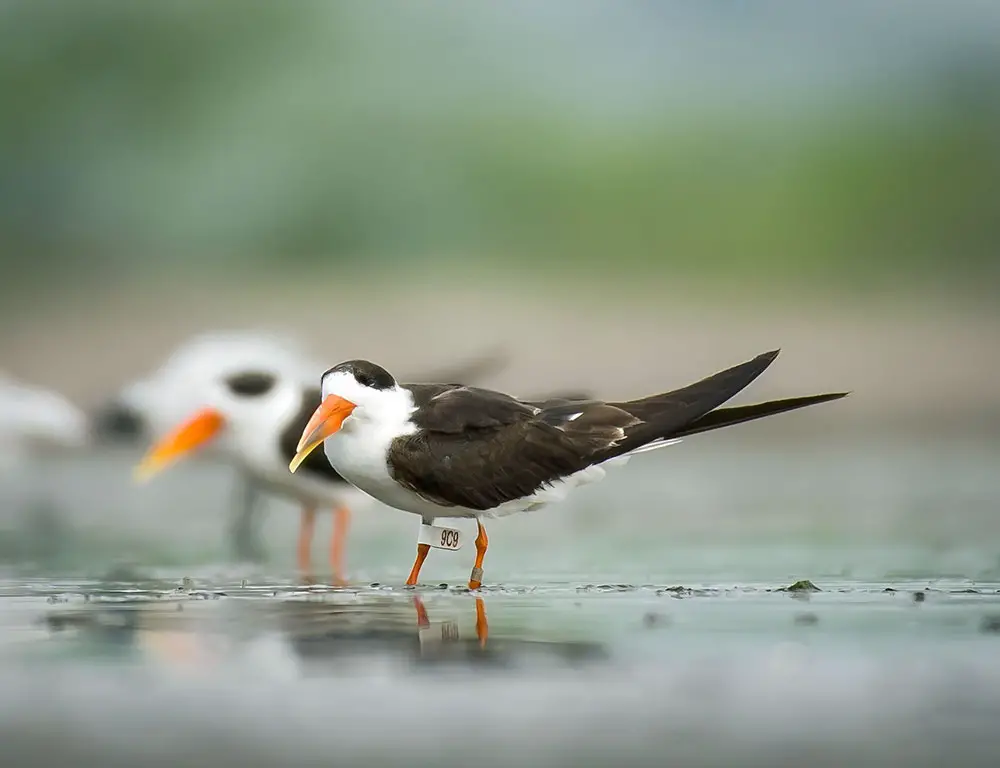
Physical Characteristics of Indian Skimmer
The Indian Skimmer (Rynchops albicollis) possesses several distinctive physical characteristics that distinguish it from other bird species:
Size and Shape
Indian Skimmers are medium-sized birds with a sleek and streamlined body shape, adapted for agile flight and efficient movement over water surfaces. They typically measure between 40 to 45 centimeters (15 to 18 inches) in length.
Plumage
The plumage of Indian Skimmers is predominantly black and white. They have black upperparts, including the wings and back, and white underparts, extending from the breast to the belly. This contrasting coloration aids in camouflage and visual communication.
Head and Neck
Indian Skimmers have a distinctive black cap extending from the top of their head to just behind their eyes. The sides of their head and neck are predominantly white, contrasting with the black cap.
Bill
One of the most notable features of the Indian Skimmer is its unique bill structure. The bill is long, slender, and knife-like, with an orange coloration.
What distinguishes it further is that the lower mandible (the ‘beak’) is noticeably longer than the upper mandible.
This adaptation is crucial for their specialized feeding behavior.
Wings
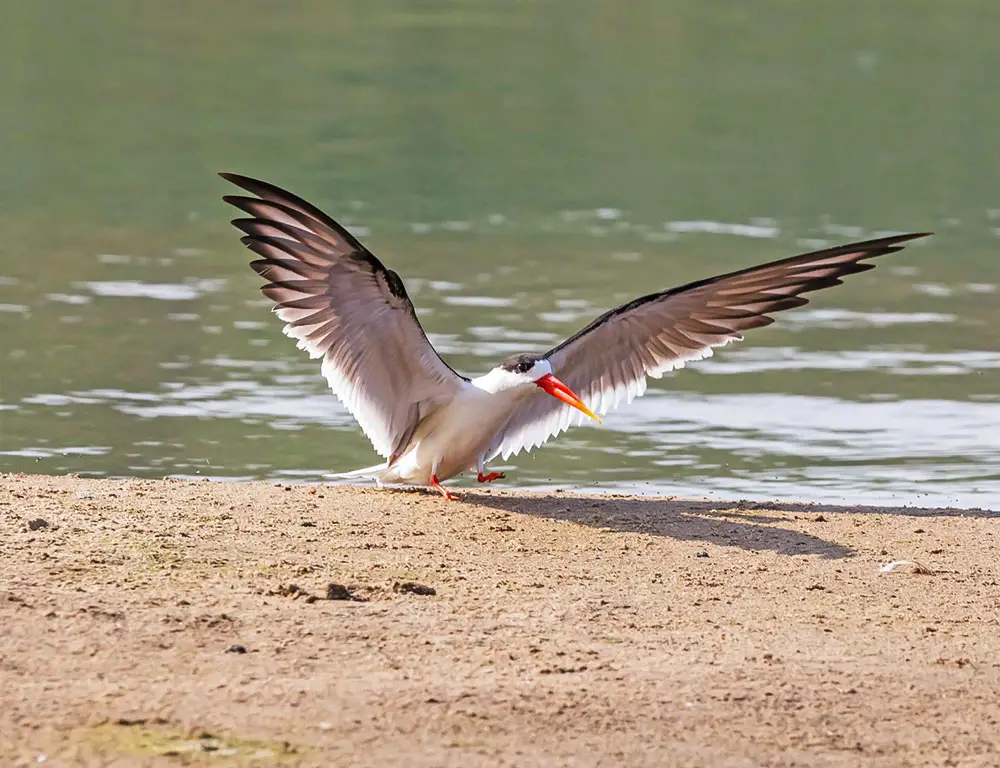
Indian Skimmers have long, pointed wings adapted for rapid flight and precise maneuvering. The wings are predominantly black, with white patches at the bases, adding to their distinctive appearance in flight.
Legs and Feet
The legs and feet of Indian Skimmers are relatively short and stout, suited for walking and perching on sandy or gravelly substrates. Their feet are webbed, which aids in swimming and maneuvering in aquatic environments.
Sexual Dimorphism
There is minimal sexual dimorphism in Indian Skimmers, with males and females generally exhibiting similar physical characteristics.
However, males may be slightly larger compared to females, but this difference is often subtle and not easily distinguishable without close observation.
Habitat and Distribution Of Indian Skimmer
The Indian Skimmer (Rynchops albicollis) is a fascinating bird species native to South Asia, particularly India. Let’s delve into its habitat and distribution:
Preferred Habitat
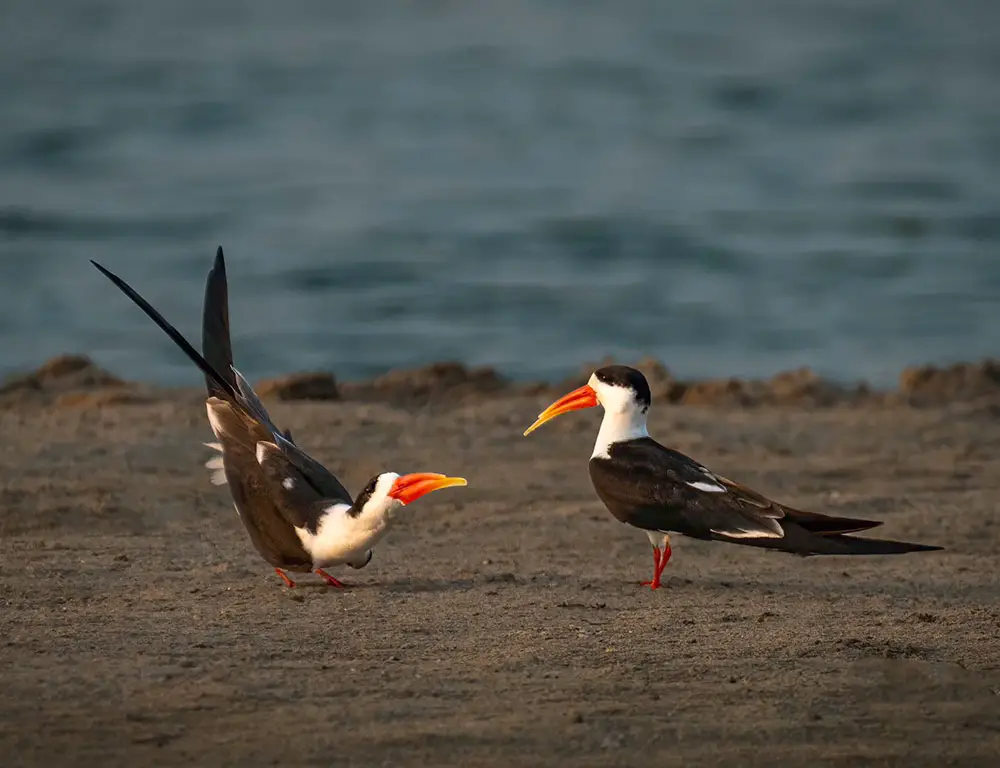
Indian Skimmers are typically found in habitats associated with large, slow-flowing rivers, lakes, and wetlands. They favor areas with sandy or gravelly shorelines and sandbanks, which provide suitable nesting and roosting sites.
These birds are often observed in habitats with open water, where they can forage for fish and other aquatic prey.
Geographic Range
The primary range of the Indian Skimmer extends across South Asia, including India, Pakistan, Nepal, Bangladesh, and Myanmar. Within this region, they inhabit river systems, lakeshores, estuaries, and coastal areas with suitable habitat conditions.
Distribution in India
In India, Indian Skimmers are commonly found along major river systems such as the Ganges, Yamuna, Chambal, Brahmaputra, and Mahanadi rivers. They are also observed in wetlands, reservoirs, and coastal areas along the eastern and western coasts of the country.
Breeding Sites
Indian Skimmers prefer nesting sites located on sandy or gravelly islands or sandbanks within rivers and lakes. These nesting sites are often isolated and exposed, protecting them from predators and human disturbances.
Breeding colonies may consist of multiple pairs of birds nesting near each other.
Foraging Areas
Indian Skimmers primarily forage in shallow waters near the edges of rivers, lakes, and wetlands. They use their unique skimming technique to catch fish near the water’s surface, relying on their sharp bills and agile flight to capture prey efficiently.
Migration
Indian Skimmers are not known for extensive long-distance migrations. Instead, they may exhibit partial migratory behavior, moving short distances within their range in response to changes in food availability, water levels, or weather conditions.
Human Impact
Human activities such as habitat destruction, pollution, sand mining, and disturbance from recreational boating can pose significant threats to Indian Skimmer populations and their habitats.
Conservation efforts focused on habitat protection, restoration, and mitigating human disturbances are essential for the long-term survival of this species.
Diet and Feeding Habits of Indian Skimmer
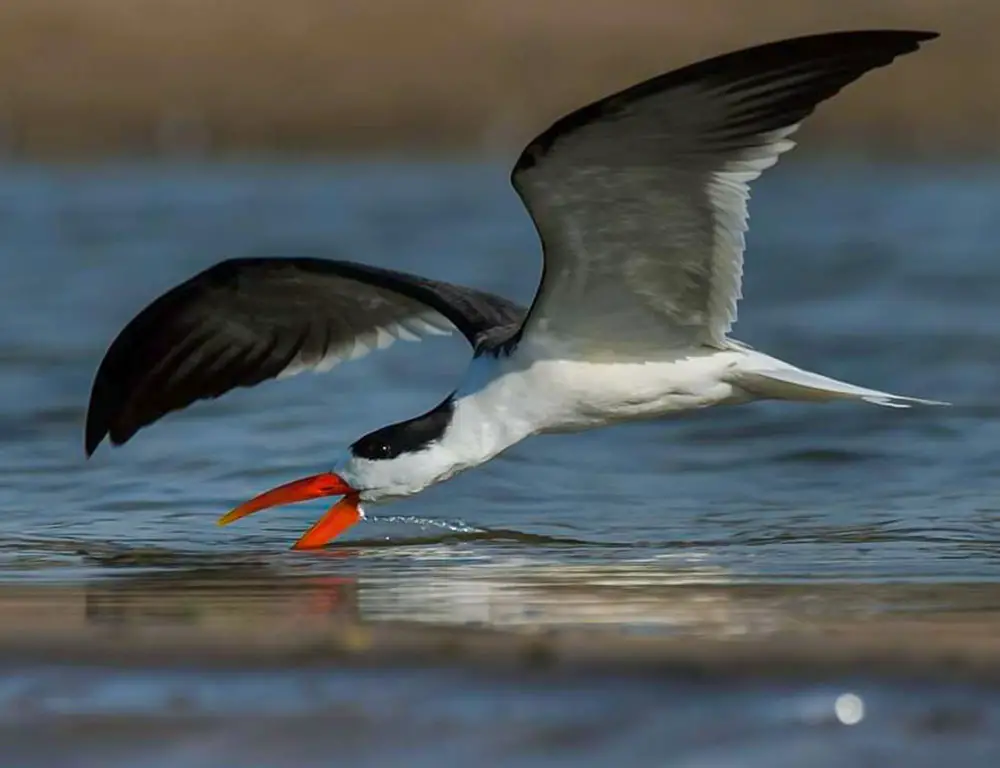
The Indian Skimmer (Rynchops albicollis) has a specialized diet and feeding habits adapted to its unique hunting strategy.
Here’s an overview of the diet and feeding habits of Indian Skimmers:
Primary Diet
Indian Skimmers primarily feed on fish, which comprise the bulk of their diet. They are skilled piscivores, meaning they specialize in catching and consuming fish. Their elongated, knife-like bills are perfectly adapted for capturing fish as they skim over the surface of water bodies.
Hunting Technique
Indian Skimmers employ a specialized hunting technique known as “skimming.” They fly low over water surfaces with their lower mandible submerged, using their keen eyesight to detect movement and locate prey.
When they spot a fish near the surface, they swiftly snap their bill shut to catch it. The elongated lower mandible is particularly effective for scooping up fish from the water.
Prey Species
Indian Skimmers primarily target small to medium-sized fish species found in rivers, lakes, and wetlands. Typical prey species include minnows, mullets, catfish, and other small freshwater fish.
They may also opportunistically consume aquatic insects and crustaceans, supplementing their diet with smaller prey items.
Foraging Behavior
Indian Skimmers are diurnal feeders, meaning they are most active during the day. They forage individually or in small groups, flying low over water bodies in search of prey.
Their foraging behavior is highly efficient, allowing them to cover large water surface areas in search of fish.
Group Feeding
Indian Skimmers may engage in group-feeding behavior, especially during the breeding season when they form colonies. Group feeding allows them to coordinate their hunting efforts, share information about prey abundance, and increase their overall foraging success.
Feeding Locations
Indian Skimmers prefer habitats with calm, shallow waters and sandy or gravelly substrates, where fish are abundant and easy to catch. They are commonly found along riverbanks, lakeshores, and wetlands with suitable foraging habitats.
Nutritional Requirements
The fish-based diet of Indian Skimmers provides them with essential nutrients, including protein, fats, vitamins, and minerals, necessary for their growth, development, and overall health.
Reproduction and Nesting of Indian Skimmer
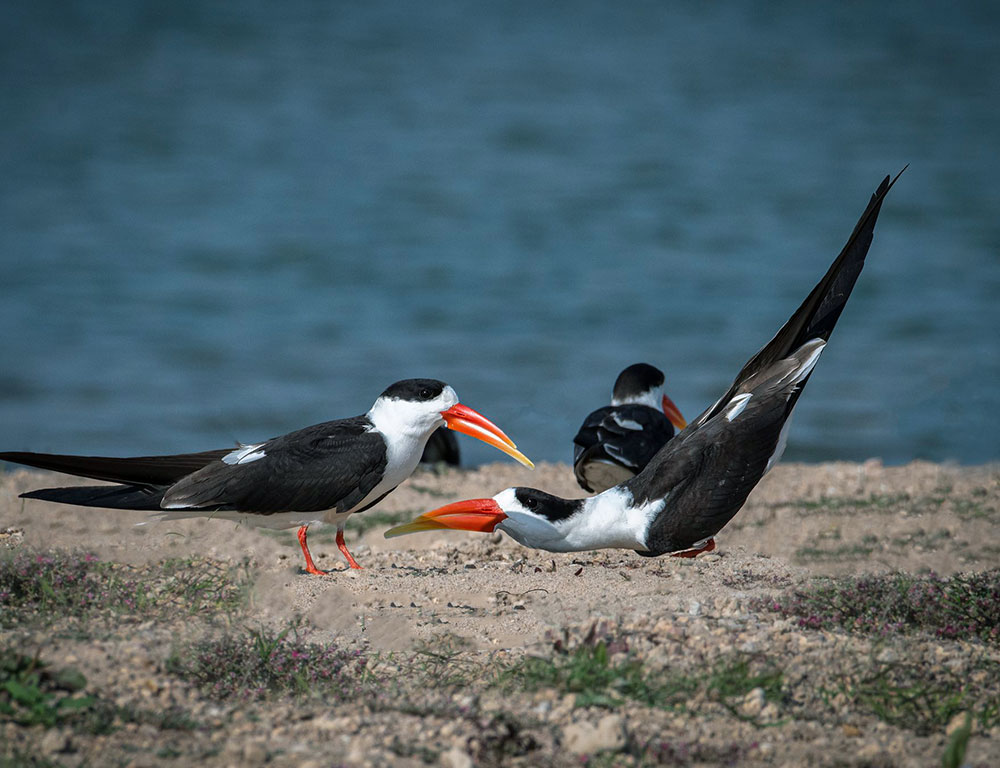
The reproduction and nesting behavior of Indian Skimmers (Rynchops albicollis) are fascinating life cycle aspects.
Here’s an overview of how these birds breed and raise their young:
Breeding Season
Indian Skimmers typically breed during the dry season, which varies depending on their geographic location. Breeding activity often peaks during the warmer months when water levels in rivers and lakes are lower, exposing suitable nesting sites on sandbanks and islands.
Courtship and Pair Bonding
Before breeding, Indian Skimmers engage in courtship displays to establish pair bonds and mating relationships. Courtship behaviors may include aerial displays, vocalizations, and mutual preening between mates.
Nest Site Selection
Indian Skimmers are colonial nesters, meaning they breed in colonies or groups. They prefer nesting sites on sandy or gravelly islands or sandbanks within rivers, lakes, or wetlands.
These sites provide a relatively safe and secluded environment for nesting and raising chicks.
Nest Construction
Indian Skimmers build shallow scrape nests on the ground, typically lined with bits of shell, pebble, or other debris for added insulation and protection. Both male and female birds participate in nest construction, with females primarily responsible for incubating the eggs.
Egg Laying and Incubation
After nest construction is complete, the female Indian Skimmer lays a clutch of 2 to 4 eggs, which are pale buff to brownish in color with dark speckles.
The eggs are incubated primarily by the female for approximately 21 to 25 days, during which the male may assist with incubation duties and foraging.
Parental Care
Once the eggs hatch, both parents care for the chicks. Indian Skimmers are attentive parents, providing their offspring warmth, protection, and food. Chicks are initially brooded by the female and fed regurgitated food by both parents.
As the chicks grow, they become more active and independent, exploring their surroundings and learning to forage.
Fledging
The chicks fledge, or leave the nest, approximately 4 to 6 weeks after hatching. At this stage, they can fly and are accompanied by their parents as they learn essential survival skills, such as hunting and navigation.
Indian Skimmers may raise multiple broods during the breeding season, especially in regions with favorable environmental conditions.
Colonial Behavior
Indian Skimmers often nest in colonies alongside other bird species, such as terns and gulls. This colonial behavior provides protection against predators and allows for communal defense of nesting territories.
Conservation Efforts for Indian Skimmer
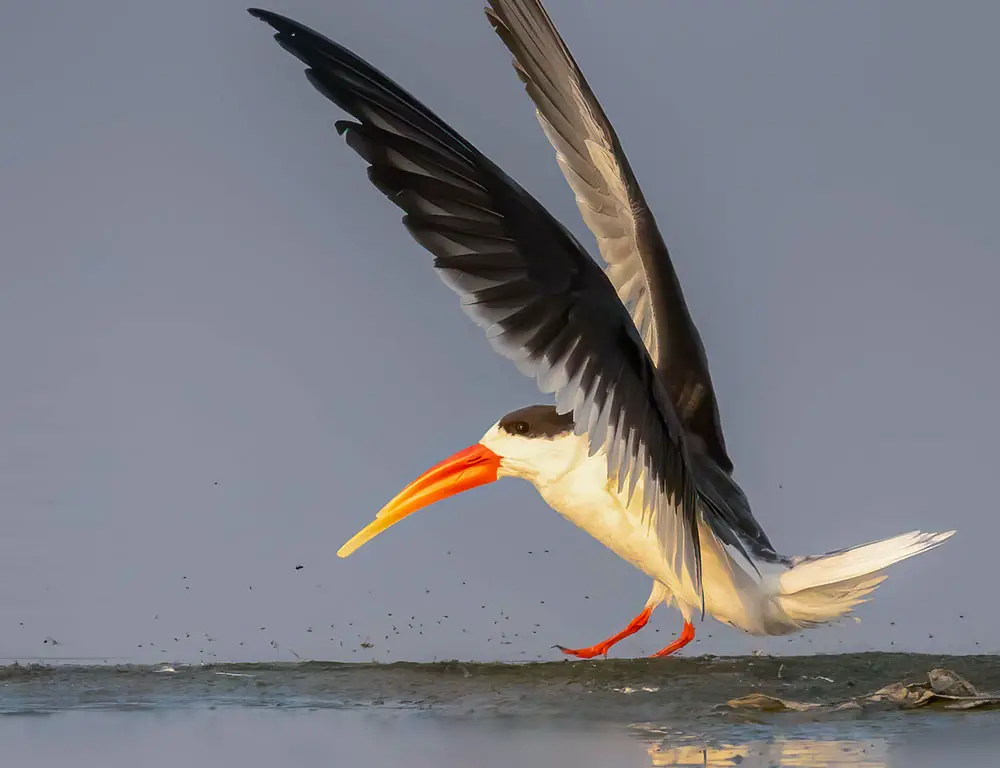
Conservation efforts for the Indian Skimmer (Rynchops albicollis) are crucial to ensure the survival of this vulnerable bird species.
Here are some key initiatives and strategies to conserve Indian Skimmer populations:
Habitat Protection
They are establishing protected areas and conservation reserves in key habitats where Indian Skimmers breed, feed, and roost is essential.
These protected areas help safeguard crucial nesting sites, foraging grounds, and migration routes from habitat degradation, disturbance, and development projects.
Regulation and Enforcement
Implementing and enforcing regulations to mitigate human activities threatening Indian Skimmer habitats is vital. This includes regulating sand mining, dam construction, pollution, and recreational activities in and around rivers, lakes, and wetlands frequented by Indian Skimmers.
Community Engagement and Education
Engaging local communities in conservation efforts through education, awareness campaigns, and community-based conservation programs is essential.
Increasing awareness about the importance of Indian Skimmers and their habitats can foster local stewardship and support for conservation initiatives.
Research and Monitoring
Researching to understand better the ecology, behavior, and population dynamics of Indian skimmers is critical for effective conservation planning and management.
Monitoring populations, habitat quality, and threats over time can help assess the effectiveness of conservation efforts and inform adaptive management strategies.
Collaboration and Partnerships
Collaborating with government agencies, non-governmental organizations (NGOs), research institutions, local communities, and international partners is essential for coordinated conservation action.
Partnerships can facilitate resource mobilization, knowledge sharing, and capacity building for effective conservation interventions.
Rescue and Rehabilitation
Establishing rescue centers and rehabilitation facilities to care for injured or orphaned Indian Skimmers can help mitigate the impact of human-related threats such as pollution, habitat destruction, and predation.
Rehabilitated birds can be released back into the wild to bolster wild populations.
Policy Advocacy
Advocating for policy measures and legal frameworks that prioritize the conservation of Indian Skimmers and their habitats at local, national, and international levels is crucial.
Policy advocacy can help secure funding, enact protective legislation, and promote sustainable development practices that benefit people and wildlife.
Population Trend of Indian Skimmers
| Year | Estimated Population |
| 2000 | 6,000-10,000 individuals |
| 2010 | 3,000-5,000 individuals |
| 2020 | Less than 2,000 individuals |
FAQs
What is the Indian Skimmer’s scientific name?
The scientific name of the Indian Skimmer is Rynchops albicollis.
How does the Indian Skimmer catch fish?
The Indian Skimmer catches fish by flying low over water surfaces with its lower mandible submerged, using its elongated bill to scoop up prey.
Where do Indian Skimmers breed?
Indian Skimmers breed on sandy or gravelly islands or sandbanks within rivers and lakes, often in colonies alongside other bird species.
What is the lifespan of an Indian Skimmer?
Indian Skimmers have a lifespan of up to 15 years in the wild.
Are Indian Skimmers migratory birds?
Indian Skimmers exhibit partial migratory behavior, moving short distances within their range in response to changes in food availability and weather conditions.
Conclusion
The Indian Skimmer emerges as a fascinating bird species and a poignant symbol of the challenges facing our planet’s biodiversity.
Its unique hunting technique and striking appearance captivate our attention, yet its dwindling population numbers underscore the urgent need for conservation action.
As we reflect on the decline of this majestic species, it reminds us of our shared responsibility to protect and preserve wildlife.
Through understanding and advocacy, we can strive to safeguard not only the Indian Skimmer but also the rich diversity of life on Earth.
Let us cherish and protect these remarkable creatures as guardians of our planet’s natural heritage.